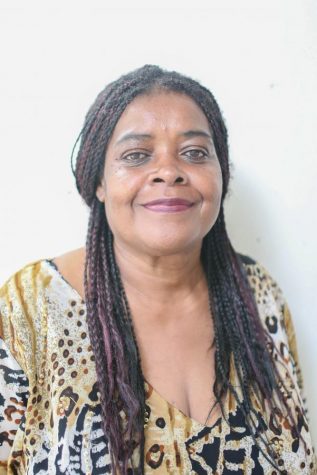Director creates film based on her boyfriend being killed by a Mexican cartel
Alejandro gathers his belongings to meet with Eva, his first love, as the muffled sound of corrido music, a notorious genre played in Mexico about the drug cartel lifestyle, is playing in the living room.
“Shh, apaga la musica,” says one of the cowboys skeptically as his friends aroudn him question why he wants to music off.
He scans through the plexiglass windows.
Shadowy figures lie dormant outside the mansion in Mexico’s vast desert.
Suddenly, a bright light shines onto his dilated, blood-shot eyes.
“La policia,” Johnny screams as his gang unleashes a barrage of bullets.
The false sense of security is quickly diminished.
Alejandro grabs his luggage and bolts out the room.
He grips his revolver, but has no intention of using it.
His heart races as he runs to the back of the house with death looming over him.
As he gets closer to the car, a police officer shoots Alejandro in the back and he slowly falls to the ground.
Another shot is fired as one of Alejandro’s friends kills the officer.
Alejandro lies on the desert ground whimpering. “Take me to Eva,” he says.
Cut.
A loud roar of applause showers over the morbid scene as a film crew wraps up in Temecula, California.
Cerra Mendez congratulates the actors for their performances.They wrap up their last day of a 4-day production at the mansion they rented.
Cerra, 24, is an El Camino student who is double majoring in film production and biological/physical science is currently working on post-production for “Fronteras,” her first independent feature film based on her boyfriends life and his untimely death.
She was able to raise money from Indiegogo, a crowdfunding campaign and her job working at UCLA as an emergency trauma technician. She plans to release the film in summer, starting with a private premiere with cast and crew then submitting to film festivals like Sundance.
Wearing a black shirt with the word “Director” on the front in bold white letters, standing at 6’1, with an hour-glass shaped body, Cerra recounts the tragedy of her boyfriend and transforms it into a redemption love tale. Like peeling an onion reaching to the center each layer, resulting in sorrow.
In late 2012, on a cold night riding in the back of an ambulance while working as an EMT, Cerra received a phone call from her boyfriend’s mom Angela Trujillo telling her, “Cerrita, solo te quieria decir que lo mataron a mi Alejandro.” I only wanted to tell you that they killed my son, Alejandro, says Angela.
In August 8, 2012 Alejandro Trujillo, also known as Alex, was murdered near a motel known as La Luna in Acapulco, according to “El Sur,” a newspaper organization in Acapulco, Mexico.
“I didn’t want to believe it at first but a week (after the news) when I was in the shower, I just broke down in tears, knowing he was gone,” Cerra said, as she recounts the day she heard about her boyfriend. Alex’s death, inspired her to commemorate his legacy in a .
“There is not a day that goes by where I don’t remember him or his smile,” says Cerra as she wipes away her tears.
Cerra was 15 when she met Alex, 19, who at the time was attending a high school in Reno. This was before he was deported during a raid at his job, back where his family resided, Acapulco. Mexico was his birth place, but his family migrated to the U.S. when he was 2 years old.
“He was a very funny and kind person,” says Cerra as she recounts her memories of Alex. While looking through her box of old memorabilia, she finds a cross necklace that was given to her by Alex’s mom after his death.
“I remember for my birthday he gave me a gold bracelet that I loved but later was stolen. Regardless it just made me feel loved and no one (had ever) shown me that in my life,” says Cerra.
In 2015, she attended a film class at El Camino College where she wrote her first screenplay for “Fronteras.” Cerra always embraced her creative side from painting on her free time to handling $2,000 cameras used to film movies.
“I just used it as an emotional outlet,” says Cerra.
She visited Alex’s family to gain more insight for her screenplay and closure. She spoke to Edgar Polanco Genchis, a cousin of Alex, and he explained that while Alex was working at a local motel to save money to be able to go back, he was taken by gang members.
The gang members were a part of a cartel and they gave Alex an ultimatum to work for them as a sicario (hitman) or be killed, Edgar told her.
“Some men who have nothing sometimes see this as the only way to make money and fall into this lifestyle,” says Edgar.
The gangs in Mexico thus have transcended into exponential killings involving over 5,000 people in 2008, according to the Latin American Weekly Report.
Cerra, after retuning to the U.S., used her newfound information and finished her script for “Fronteras.” In this alternate universe, Alex sees Cerra’s character one last time before dying.
“I wanted to preserve Alex’s innocence so in this film, knowing in reality he did bad things but due to the circumstances he dealt with he had to become this monster in order to see Eva again,” says Cerra.
Cerra aspires to branch out and orchestrate an ensemble of independent filmmakers in Los Angeles who need help funding their projects using private investors.
Cerra wants to be an activist and have a message in all her films while at the same time being entertaining. Cerra says she plans to make more films with political undertones but still wants them to be accessible for movie goers.
“This is what I love about film: (it is that) I have the power to make people feel how I felt with my first love being Alex and following his journey,” says Cerra.










